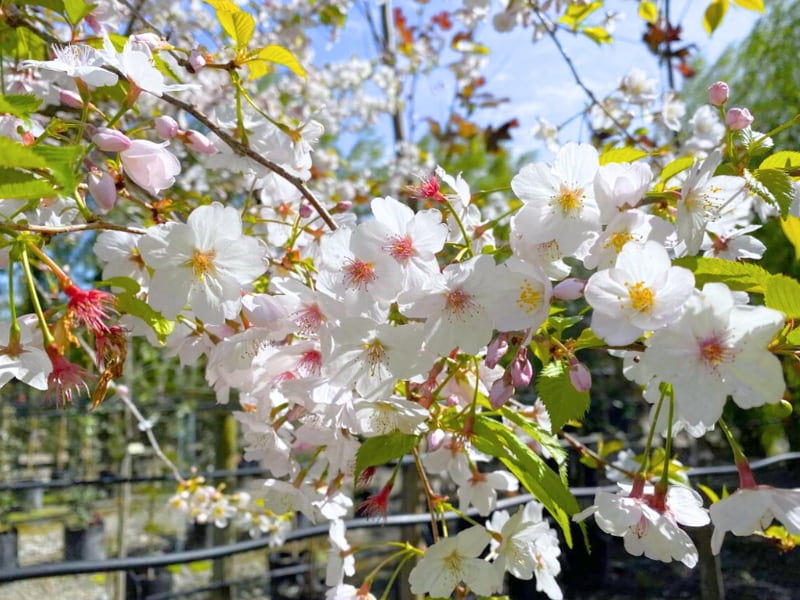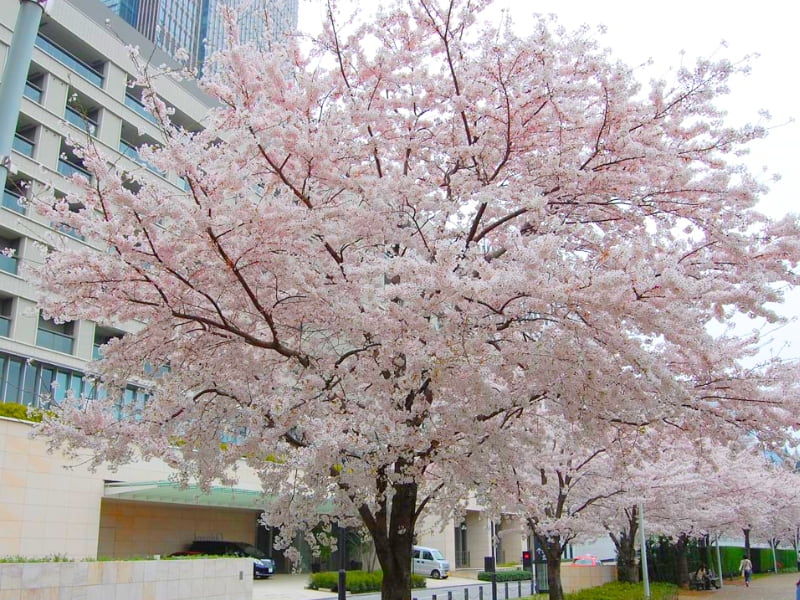Yoshino Cherry trees, also commonly known as Somei-Yoshino or Prunus × yedoensis, are renowned for their stunning display of delicate, fragrant blossoms in early spring. These ornamental trees, a staple in landscapes and gardens, offer a spectacular show of pale pink to white flowers, creating a truly breathtaking visual experience, the related species are often found intermingled.
At Gardencenterpoint.com, we provide you with comprehensive resources to help you successfully cultivate and enjoy these magnificent specimens. This guide will cover everything you need to know, from selecting the right flowering cherry trees to providing optimal planting and ongoing care, ensuring a beautiful addition to your landscape. We cover all your cherry blossom tree needs.

I. Understanding the Yoshino Cherry Tree (and its Allure)
Before diving into the specifics of planting and care, it’s essential to understand what makes the Yoshino Cherry (Prunus × yedoensis) so special. This section delves into its origin, characteristics, and cultural significance. We explore why it’s such a sought-after ornamental tree and how it differs from other cherry varieties.
| Common name | Yoshino Cherry, Somei-Yoshino, Tokyo Cherry |
| Botanical name | Prunus × yedoensis |
| Family | Rosaceae |
| Genus | Prunus |
| Species | yedoensis (It is a hybrid of P. speciosa (Oshima cherry) and P. pendula f. ascendens.) |
| Origin | Japan (thought to be) |
| Native | Japan |
| Life cycle | Perennial |
| Plant type | Deciduous Tree |
| Hardiness zone | 5-8 (USDA) |
| Sunlight | Full Sun (At least 6 hours of direct sunlight per day) |
| Maintenance | Moderate |
| Water | Moderate (Needs regular watering, especially during dry spells) |
| Drainage | Well-Drained (Crucial to prevent root rot) |
| Spacing | 20-40 feet apart, depending on the specific cultivar and desired canopy spread. |
| Flowering period | Spring (Typically March-April, depending on location and weather) |
| Height | 20-50 feet (Can reach up to 70 feet in optimal conditions, but typically stays within the 20-50 foot range) |
| Width/Spread | 25-40 feet |
| Growth rate | Medium to Fast (13-24 inches per year, possibly more when young and under ideal conditions) |
| Flower color | Pale Pink to White (The flowers are typically very pale pink, almost white, when fully open) |
| Stem color | Gray-Brown (Bark is smooth and reddish-brown when young, becoming gray-brown and slightly furrowed with age) |
| Flower benefit | Spectacular Spring Bloom, Attracts Pollinators (bees and other beneficial insects) |
| Garden style | Specimen Tree, Avenue Planting, Flowering Tree Border, Japanese Garden, Woodland Garden |
| Uses | Ornamental, Shade Tree, Spring Interest |
| Soil pH | Slightly Acidic to Neutral (6.0-7.0) |
| Soil type | Loamy, Well-drained (Adaptable to various soil types, but prefers fertile, well-drained loam) |
| Fertilizer | Balanced fertilizer in early spring (before new growth begins) |
| Propagation | Grafting (Yoshino Cherry Trees are typically propagated by grafting onto a rootstock to ensure desired characteristics) |
| Pruning | Prune after flowering to remove dead, damaged, or crossing branches. Minimal pruning is generally required. |
| Pests and Diseases | Can be susceptible to certain pests and diseases, including aphids, spider mites, borers, canker, and leaf spot. (Gardencenterpoint recommends regular monitoring and preventative measures) |
| Deer Resistance | Moderately Resistant (Young trees may be more vulnerable to deer browsing) |
| Toxicity | The leaves, stems, and seeds contain cyanogenic glycosides, which can be toxic if ingested in large quantities. (Keep away from pets and small children) |
| Salt Tolerance | Moderate |
| Drought Tolerance | Moderate once established |
| Lifespan | Relatively short-lived compared to some other tree species, typically 40-50 years, although some may live longer with excellent care. |
| Fruit | Small, black cherries (Not typically consumed by humans, but attractive to birds) |
- Origin and History: The Yoshino Cherry is a hybrid of Prunus speciosa (Oshima cherry) and Prunus subhirtella (Edo higan). While its precise origin is debated, it is widely believed to have originated in Japan, likely sometime in the mid-19th century. It quickly gained popularity for its rapid growth, abundant flowering, and graceful form.
- Botanical Characteristics:
- Growth Habit: Deciduous tree, typically reaching a height and spread of 20-40 feet (6-12 meters), though some cultivars can reach 50 feet (15 meters) or more.
- Shape: Often vase-shaped or spreading, with a rounded crown.
- Bark: Smooth, reddish-brown bark with prominent horizontal lenticels (small pores).
- Leaves: Alternate, simple, ovate to lanceolate leaves with serrated margins. Leaves emerge bronze-green, mature to a dark green, and turn yellow to bronze in the fall.
- Flowers: The hallmark feature! Clusters of 5-petaled flowers, typically pale pink (though some cultivars are white or deeper pink). The flowers are slightly fragrant.
- Bloom Time: Typically blooms in early spring (March-April), depending on the climate and specific cultivar. The bloom period is relatively short, lasting only 1-2 weeks.
- Fruit: Produces small, black, cherry-like fruits that are generally not palatable to humans but are attractive to birds.
- Cultivars: While “Yoshino Cherry” often refers to the species Prunus × yedoensis, there are several named cultivars with slight variations in flower color, size, and growth habit. Some popular cultivars include:
- ‘Akebono’ (Daybreak Cherry): Slightly deeper pink flowers.
- ‘Shidare Yoshino’ (Weeping Yoshino Cherry): Pendulous branches create a weeping form.
- ‘Afterglow’: Rich pink flowers.
- ‘Snow Fountains’: A smaller, weeping variety.
- Cultural Significance: The Yoshino Cherry holds immense cultural significance, particularly in Japan, where it is a symbol of spring, renewal, and the ephemeral nature of life. The annual cherry blossom viewing (hanami) is a deeply ingrained tradition. The National Cherry Blossom Festival in Washington, D.C., features thousands of Yoshino Cherry trees, a gift from Japan in 1912, symbolizing the enduring friendship between the two nations. A study by the University of Washington highlighted the positive psychological impact of viewing cherry blossoms, linking it to reduced stress and improved mood.
- Distinguishing Features: It’s important to distinguish Yoshino Cherries from other cherry species, such as the Kwanzan Cherry (Prunus serrulata ‘Kwanzan’), which has double-petaled, deep pink flowers and blooms later in the spring. Yoshino Cherries are known for their earlier bloom, single-petaled flowers, and generally paler color.

II. Planting Your Yoshino Cherry Tree: A Step-by-Step Guide
This section provides a comprehensive, step-by-step guide to successfully planting a Yoshino Cherry tree, ensuring its health and longevity. We cover everything from site selection and soil preparation to the actual planting process and initial care.
- Step 1: Choosing the Right Time to Plant:
- Optimal Timing: The best time to plant a Yoshino Cherry tree is in the fall or early spring. Fall planting allows the tree to establish its roots before the ground freezes, while spring planting gives it a head start before the summer heat.
- Avoid Extreme Temperatures: Avoid planting during periods of extreme heat or cold.
- Step 2: Selecting the Ideal Location:
- Sunlight: Yoshino Cherries thrive in full sun, requiring at least 6 hours of direct sunlight per day for optimal flowering and growth.
- Soil: They prefer well-drained soil that is slightly acidic to neutral (pH 6.0-7.0). Avoid heavy clay soils that retain excessive moisture.
- Space: Consider the mature size of the tree (20-40 feet tall and wide) and ensure it has ample space to grow without overcrowding. Avoid planting too close to buildings, power lines, or other trees.
- Air Circulation: Good air circulation helps prevent fungal diseases.
- Step 3: Preparing the Soil:
- Soil Testing: Conduct a soil test to determine its pH and nutrient levels. Amend the soil as needed based on the test results.
- Soil Amendment: If your soil is heavy clay or poorly drained, amend it with organic matter such as compost, peat moss, or aged manure. This will improve drainage, aeration, and nutrient content.
- Digging the Hole: Dig a hole that is twice as wide as the root ball and just as deep.
- Step 4: Planting the Tree:
- Bare-Root Trees: If planting a bare-root tree, soak the roots in water for several hours before planting. Gently spread out the roots.
- Container-Grown Trees: Carefully remove the tree from its container, being careful not to damage the roots. Loosen any circling roots.
- Balled and Burlapped Trees: Place the tree in the hole, making sure the top of the root ball is level with the surrounding ground. Remove any twine or wire securing the burlap. You can leave the burlap in place, as it will decompose naturally.
- Backfilling: Backfill the hole with the amended soil, gently tamping it down to eliminate air pockets.
- Watering: Water the tree deeply after planting to settle the soil.
- Step 5: Initial Care:
- Mulching: Apply a 2-3 inch layer of organic mulch (such as wood chips or shredded bark) around the base of the tree, keeping it away from the trunk. Mulch helps retain moisture, suppress weeds, and regulate soil temperature.
- Watering: Water the tree regularly, especially during dry periods. Aim for about 1 inch of water per week, either from rainfall or irrigation.
- Staking (if necessary): Young trees may need to be staked for support, especially in windy areas. Use tree stakes and soft ties, and remove them after a year or two.
- Fertilizing Apply a balanced, slow-release fertilizer in the spring, use a product formulated for flowering trees to provide the nutrients needed, avoid over-fertilizing, which can harm the tree.
III. Ongoing Care and Maintenance of Your Yoshino Cherry
This section details the ongoing care and maintenance practices required to keep your Yoshino Cherry tree healthy and thriving for years to come. We cover pruning, watering, fertilizing, pest and disease management, and winter protection.
- Pruning:
- Timing: Prune Yoshino Cherries in late winter or early spring, before new growth begins.
- Purpose: Pruning helps maintain the tree’s shape, remove dead or damaged branches, and improve air circulation.
- Technique: Remove any crossing, rubbing, or diseased branches. Thin out the canopy to allow for better light penetration. Avoid heavy pruning, as it can stimulate excessive growth and reduce flowering.
- Watering:
- Established Trees: Once established, Yoshino Cherries are relatively drought-tolerant. However, they still benefit from occasional deep watering, especially during extended dry periods.
- Monitoring: Monitor the soil moisture and water when the top few inches of soil feel dry.
- Fertilizing:
- Annual Feeding: Fertilize annually in early spring with a balanced, slow-release fertilizer formulated for flowering trees.
- Soil Testing: Conduct a soil test every few years to monitor nutrient levels and adjust fertilization accordingly.
- Pest and Disease Management:
- Common Pests: Yoshino Cherries can be susceptible to certain pests, including aphids, spider mites, and borers.
- Common Diseases: They can also be affected by diseases such as powdery mildew, leaf spot, and root rot.
- Prevention: Maintaining good air circulation, proper watering, and avoiding over-fertilization can help prevent many pest and disease problems.
- Treatment: If pests or diseases are present, treat them promptly with appropriate insecticides or fungicides. Consult with a local arborist or extension service for specific recommendations.
- Winter Protection:
- Young Trees: Young trees may benefit from winter protection in colder climates. Wrap the trunk with burlap or tree wrap to protect it from sunscald and rodent damage.
- Mulching: Maintain a layer of mulch around the base of the tree to insulate the roots.
IV. Enjoying the Beauty: Maximizing the Yoshino Cherry Experience
- Blossom Viewing (Hanami):
- Timing: Pay attention to bloom forecasts to catch the peak bloom period, which typically lasts only 1-2 weeks.
- Location: Visit local parks, gardens, or arboretums that feature Yoshino Cherry trees. Many cities have annual cherry blossom festivals.
- Picnicking: Pack a picnic and enjoy the beauty of the blossoms with friends and family, following the traditional Japanese custom of hanami.
- Photography:
- Lighting: The best time to photograph cherry blossoms is during the “golden hour” (shortly after sunrise or before sunset) when the light is soft and warm.
- Composition: Experiment with different angles and compositions to capture the beauty of the blossoms.
- Macro Photography: Use a macro lens to capture the intricate details of the flowers.
- Finding Local Displays:
- Online Resources: Use online resources such as botanical garden websites, park websites, and local tourism websites to find locations with Yoshino Cherry trees near you.
- Gardencenterpoint.com: We provide links to reputable nurseries and garden centers where you can purchase Yoshino Cherry trees and related products.
- Purchasing Yoshino Cherry Trees:
- Nurseries and Garden Centers: Purchase trees from reputable local nurseries or garden centers.
- Online Retailers: Be cautious when purchasing trees online. Choose reputable retailers with good reviews and guarantees.
- Consider Cultivars: Research different cultivars to find one that best suits your needs and preferences.
- Related Products:
- Gardening Tools: Invest in quality gardening tools, such as pruners, loppers, and shovels.
- Fertilizers: Purchase fertilizers specifically formulated for flowering trees.
- Mulch: Use organic mulch to retain moisture and suppress weeds.
- Tree Care Products: Consider purchasing tree wraps, stakes, and ties if needed.

V. Troubleshooting Common Yoshino Cherry Problems
- Problem: Lack of Bloom:
- Possible Causes: Insufficient sunlight, improper pruning, nutrient deficiencies, late frost, or young tree (may take a few years to bloom).
- Solutions: Ensure the tree receives at least 6 hours of sunlight, prune correctly in late winter or early spring, fertilize appropriately, protect from late frosts if possible, and be patient with young trees.
- Problem: Yellowing Leaves:
- Possible Causes: Overwatering, underwatering, nutrient deficiencies, poor drainage, or disease.
- Solutions: Check soil moisture, adjust watering accordingly, conduct a soil test, improve drainage if necessary, and treat any diseases promptly.
Problem: Leaf Spot:
- Possible Cause: Fungal disease.
- Solutions: Improve air circulation, avoid overhead watering, and apply a fungicide if necessary.
Problem: Aphids or Spider Mites:
- Possible Cause: Insect infestation.
- Solutions: Spray with insecticidal soap or horticultural oil.
Problem: Bark Splitting:
- Possible Cause: Sunscald or frost cracking, rapid temperature changes.
- Solutions: Protect yound trees trunk with wrap during winter. Avoid late-season fertilizing.
VI. Frequently Asked Questions (FAQs) about Yoshino Cherry Trees
- Q: How long do Yoshino Cherry trees live?
- A: Yoshino Cherry trees typically live for 20-40 years, although some can live longer with proper care.
- Q: Are Yoshino Cherry trees messy?
- A: They can be somewhat messy during the bloom period when the petals fall. The small fruits can also attract birds.
- Q: Are Yoshino Cherry trees deer-resistant?
- A: They are considered moderately deer-resistant, but deer may browse on young trees or new growth.
- Q: Can I grow a Yoshino Cherry tree in a container?
- A: Smaller, dwarf cultivars can be grown in large containers, but they will not reach their full size.
- Q: When is the best time to prune a Yoshino Cherry tree?
- A: Late winter or early spring, before new growth begins.
- Q: What is the best fertilizer for Yoshino Cherry trees?
- A: A balanced, slow-release fertilizer formulated for flowering trees.
- Q: How much water do Yoshino Cherry trees need?
- A: About 1 inch of water per week, either from rainfall or irrigation.
- Q: Where can I buy a Yoshino Cherry tree near me?
- A: Check with local nurseries and garden centers. Gardencenterpoint.com provides links to reputable retailers.
- Q: What is the difference between a Yoshino Cherry and a Kwanzan Cherry?
- A: Yoshino Cherries bloom earlier, have single-petaled, pale pink flowers. Kwanzan Cherries bloom later, have double-petaled, deep pink flowers.
- Q: How can I tell if my Yoshino Cherry tree is healthy?
- A: Look for vibrant green leaves, abundant blossoms, and healthy bark.
The Yoshino Cherry tree is a truly spectacular addition to any landscape, offering a breathtaking display of blossoms in early spring. By following the guidelines outlined in this comprehensive guide, you can successfully plant, care for, and enjoy these magnificent trees for years to come.

Leave a Reply